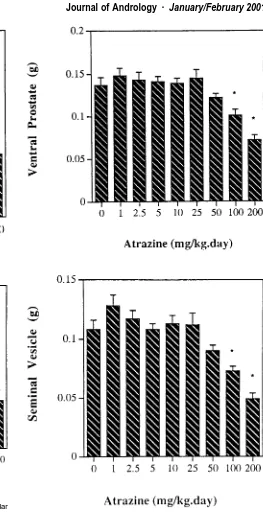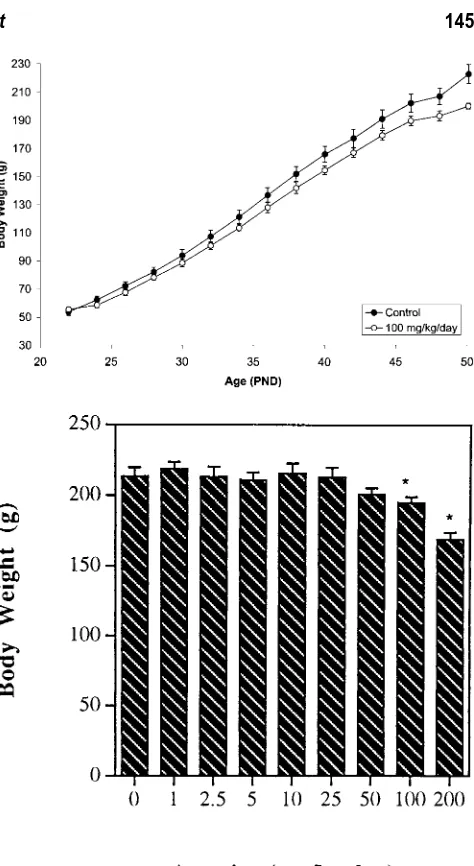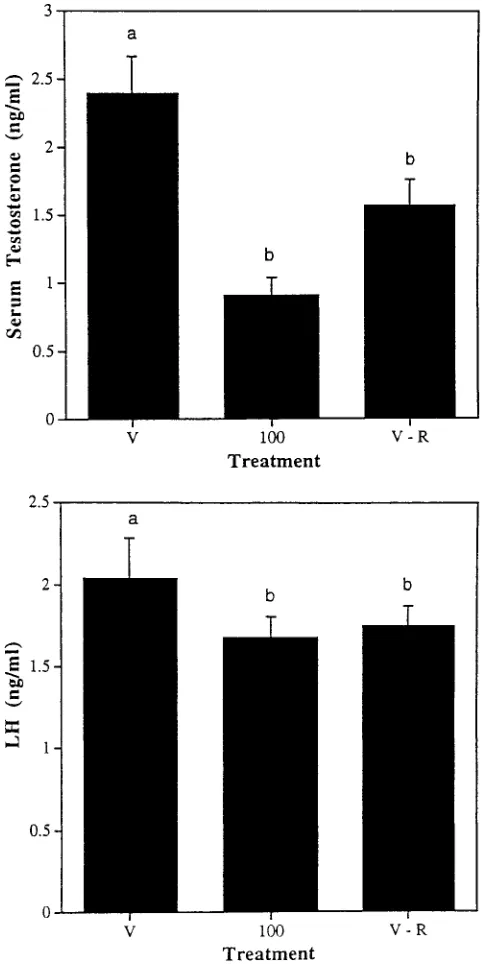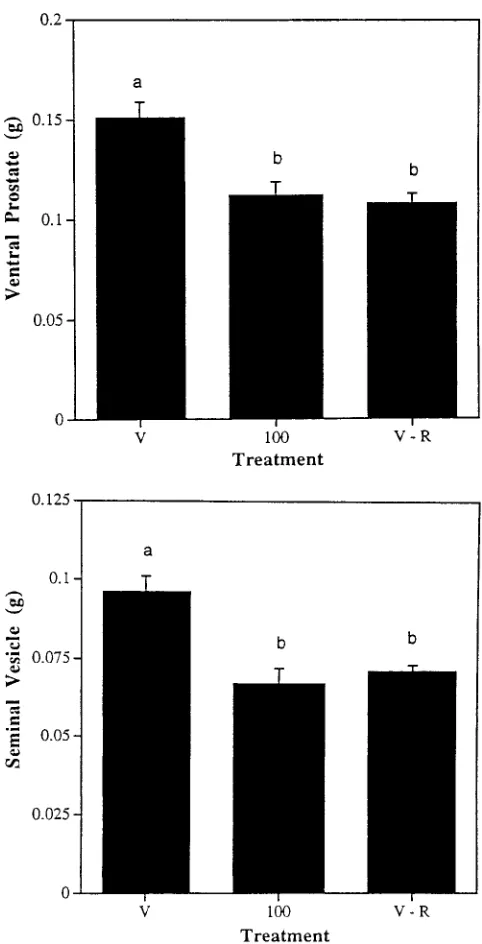142
Atrazine Effects on Testosterone Levels and
Androgen-Dependent Reproductive Organs in Peripubertal Male Rats
STEPHANIE V. TRENTACOSTE,* ANDREW S. FRIEDMANN,* ROBERT T. YOUKER,* CHARLES B. BRECKENRIDGE,† AND BARRY R. ZIRKIN*
From the *Division of Reproductive Biology, Department of Biochemistry and Molecular Biology, Johns Hopkins School of Hygiene and Public Health, Baltimore, Maryland; and †Novartis Crop Protection, Inc, Greensboro, North Carolina.
ABSTRACT: Previous studies have reported that atrazine, a widely used herbicide that selectively inhibits photosynthesis in broadleaf and grassy weeds, has adverse effects on reproductive function in the male, suggesting a direct effect of atrazine on the hypothalamic-pituitary-testicular axis. As yet, however, no studies have critically examined the doses of atrazine that elicit such effects, and few have focused on the mechanism by which atrazine acts. Herein we report a dose-response study of the effects of atrazine ingestion on repro-ductive function in male Sprague-Dawley rats during a critical de-velopmental period, the peripubertal period. Atrazine was adminis-tered by gavage to rats from day 22 to day 47 of age, at doses of 1–200 mg/kg body weight per day. Atrazine administration of up to 50 mg/kg per day had no effect on any of the measured variables. Serum testosterone concentration was reduced by atrazine at doses of 100 and 200 mg/kg per day, as were seminal vesicle and ventral prostate weights. Intratesticular testosterone concentration was duced in parallel with serum testosterone, suggesting that the re-ductions in serum testosterone resulted from reduced testosterone production by Leydig cells or from changes in testosterone metab-olism within the testis, or both. Serum luteinizing hormone (LH) con-centration was reduced despite the reduced serum testosterone,
suggesting an effect on the hypothalamus, the pituitary gland, or both. At the termination of the study, the average body weight of rats receiving atrazine at 100 mg/kg per day was found to be re-duced by approximately 9%. This suggested the possibility that the effects of atrazine on the reproductive tract may not be direct, but rather, the noted deficits of the male reproductive tract resulted from reduced food intake by the treated rats. We tested this by feeding control (vehicle-gavaged) rats amounts of food equivalent to that consumed by the atrazine-fed rats, and then assessing reproductive tract endpoints. Even mild food restriction resulted in reductions in serum testosterone concentration, in the weights of androgen-de-pendent organs, and in serum LH concentration; the same deficits that were seen in atrazine-gavaged rats. Indeed, the effects of at-razine on the male reproductive tract seen in rats receiving atat-razine at greater than 50 mg/kg per day could not be distinguished from the effects of reduced food consumption. These results suggest that caution must be exercised before concluding that atrazine (or any potentially toxic chemical) has direct, detrimental effects.
Key words: Herbicide, male reproduction, hypothalamic-pituitary-testicular axis, peripubertal period.
J Androl 2001;22:142–148
A
number of reports have suggested that atrazine, a widely used herbicide that selectively inhibits pho-tosynthesis in broadleaf and grassy weeds, may have ad-verse effects on reproductive function in both females and males. In female adults, dietary exposure to atrazine has been reported to produce a lengthening of the estrous cy-cle, reduction of estradiol-induced uterine weight gain, reduced uterine cytosolic progesterone receptor binding, or early onset of mammary and pituitary tumors (Eldridge et al, 1994a, 1994b; Simic et al, 1994; Tennant et al, 1994; Wetzel et al, 1994; Connor et al, 1996; Cooper et al, 1996; Stevens et al, 1999). In males, Kniewald andSupported by a grant from Novartis Crop Protection, Inc (B.R.Z.). Correspondence to: Dr Barry R. Zirkin, Division of Reproductive Bi-ology, Department of Biochemistry and Molecular BiBi-ology, The Johns Hopkins University School of Hygiene and Public Health, Baltimore, MD 21205 (e-mail: brzirkin@jhsph.edu).
Received for publication June 6, 2000; accepted for publication August 2, 2000.
his colleagues have reported that atrazine exposure may result in suppression of the conversion of testosterone to 5␣-dihydrotestosterone (DHT) in the hypothalamus, an-terior pituitary, and prostate; reduced pituitary and pros-tate weights; reduction of DHT binding to the androgen receptor; and reduced number and motility of spermato-zoa (Kniewald et al, 1979, 1987, 1995, 2000; Babic-Gojmerac et al, 1989; Simic et al, 1991). As yet, however, few studies have critically examined the doses of atrazine that elicit such effects, or have focused on the mechanism by which atrazine acts.
not-143 Trentacoste, et al · Atrazine and the Male Reproductive Tract
ed that at the termination of the study, the average body weight of rats receiving atrazine at 100 mg/kg per day was reduced by approximately 9%. This suggested the possibility that the effects of atrazine on the reproductive tract may not be direct, but rather that deficits of the male reproductive tract resulted from reduced food intake. We tested this by feeding rats amounts of food that were equivalent to that consumed by the atrazine-fed rats, and then assessing reproductive tract endpoints. Food restric-tion resulted in reducrestric-tions in serum and intratesticular tes-tosterone concentrations, androgen-dependent organ weights, and serum LH concentration, the same deficits seen in atrazine-gavaged rats. Indeed, the effects of at-razine on the male reproductive tract that were seen in rats receiving atrazine at greater than 50 mg/kg per day could not be distinguished from the effects of reduced food consumption.
Materials and Methods
Chemicals
Atrazine technical, 96.1% purity, was supplied by Novartis, Inc (Greensboro, NC). Atrazine suspensions were prepared in 0.5% carboxymethylcellulose (medium viscosity) by Covance Labo-ratories (Vienna, Va). The suspensions were stored at 4⬚C.
Tes-tosterone antibody was from ICN Biomedicals, Inc (Costa Mesa, Calif), and tritiated testosterone was from NEN Products (Bos-ton, Mass).
Experimental Design
Dose Response Study—Sprague-Dawley rats of 17–20 days of
age were purchased from Harlan (Indianapolis, Ind). After wean-ing (day 21), the rats were individually caged and received food and water ad libitum on a schedule of 12 hours of light and 12 hours of dark. Rats received atrazine by daily gavage from day 22 to day 47 at doses of 1, 2.5, 5, 10, 25, 50, 100, or 200 mg/ kg body weight per day (n⫽9–12 rats per dose). Control
ani-mals (n⫽11) received the same weight-based volume of vehicle (0.5% carboxymethylcellulose). The day of preputial separation was determined for control rats and for rats receiving atrazine at 100 and 200 mg/kg per day. Rats were killed by decapitation 24 hours after the last gavage, at age 48 days. Trunk blood was collected, centrifuged at 3000 ⫻g at 4⬚C for 10 minutes, and
then stored at⫺80⬚C for subsequent assay. To collect fluid from the interstitial compartment of the testis, the tunica albuginea was perforated at the distal pole of the testis, and fluid was drained by placing the testis in a holder and centrifuging at 54
⫻g at 0⬚C for 15 minutes (Turner et al, 1984). The collected fluid was stored at ⫺80⬚C for subsequent assay. Body weight
and the weights of the testes, epididymides, ventral prostate, and seminal vesicles (dry weight, with the coagulating gland re-moved) were recorded for each rat.
Food Restriction Study—As in the dose response study,
Sprague-Dawley rats, after weaning, were individually caged. One group of 22-day-old rats (n⫽13) received 100 mg/kg
at-razine per day, and the amount of food that each rat consumed on a daily basis was measured. A second group of rats (n⫽14)
received the vehicle by gavage. On each day of the study, each of these rats was fed the mean daily intake of food consumed by the atrazine-administered group on the previous day. Rats in a third group (n⫽16) received the vehicle by gavage and were
fed ad libitum. Rats were killed by decapitation 24 hours after the last gavage, at age 48 days, and evaluated as described ear-lier.
All animal protocols were approved by The Johns Hopkins University Institutional Animal Care and Use Committee.
Assays
Testosterone concentration in the serum and interstitial fluid was determined by radioimmunoassay (RIA), as previously reported (Turner et al, 1984). The serum concentration of LH was deter-mined by RIA using a Biotrak assay system (Amersham, Ar-lington Heights, Ill).
Statistical Analysis
One-way analysis of variance (ANOVA) was used to analyze group means. In cases in which significant differences were found among groups (P ⬍ .05), individual groups were
com-pared with each other by Fisher’s least significant difference test. Means were considered different at P⬍.05.
Results
As seen in Figure 1, serum testosterone concentrations were not significantly different from the control value at atrazine doses of 1–50 mg/kg per day, but were reduced from the control at the 100 and 200 mg/kg per day doses by 34% and 32%, respectively. Reductions in interstitial fluid testosterone concentration (Figure 1) paralleled re-ductions in serum testosterone concentration; at 100 and 200 mg/kg per day, when serum testosterone concentra-tions were reduced from the control value, interstitial fluid testosterone concentrations also were significantly re-duced, by 41% and 45%, respectively. Interstitial fluid testosterone concentration was not altered at atrazine dos-es of ldos-ess than 100 mg/kg per day, as also was the case for serum testosterone.
144 Journal of Andrology · January/February 2001
File # 03em
Figure 1. Testosterone concentration in the serum (above) and testicular interstitial fluid (below) of rats administered atrazine (1–200 mg/kg per day) by gavage. *Significantly different from control (0 mg/kg) values (P
⬍.05).
Figure 2. Ventral prostate (above) and seminal vesicle (below) weights in rats administered atrazine (1–200 mg/kg per day) by gavage. *Signif-icantly different from control (0 mg/kg) values (P⬍.05).
mg/kg per day compared with controls (postnatal day [pnd] 44 vs pnd 41), and by about 4 days in rats receiving 200 mg/kg per day.
Figure 3 shows the effect of atrazine dose on serum levels of LH. Atrazine doses of 100 and 200 mg/kg per day resulted in reductions in serum LH concentration of 17% and 20%, respectively, from the control value. (The reduction in LH concentration reached significance only at the 200 mg/kg per day dose.)
145 Trentacoste, et al · Atrazine and the Male Reproductive Tract
Figure 3. LH concentration in the serum of rats administered atrazine (1– 200 mg/kg per day) by gavage. *Significantly different from control (0 mg/kg) value (P⬍.05).
Figure 4. Above: Body weights over time of vehicle-treated (control) rats and rats administered atrazine at 100 mg/kg per day by gavage. Below: Mean terminal body weights of rats administered atrazine (1–200 mg/kg per day) by gavage. *Significantly different from control (0 mg/kg) value (P⬍.05).
not be direct, but rather result at least in part from food deprivation. To examine this possibility, a second study was designed that involved 3 groups: 1) vehicle-gavaged rats fed ad libitum (controls), 2) rats gavaged with 100 mg/kg atrazine per day, and 3) vehicle-gavaged rats pro-vided each day with the mean daily intake of food con-sumed by the 100 mg/kg per day group on the previous day. Over the course of the study, rats receiving atrazine at 100 mg/kg per day ate an average of 10% less food per day than the vehicle-gavaged controls (total of 420 g versus 463 g, respectively), and gained less weight (Fig-ure 5). At the termination of the study, the average weight of the vehicle-gavaged rats that had been fed amounts of food comparable to that consumed by the 100 mg/kg per day group also was reduced by about 10% from the ad libitum-fed controls (Figure 5). It is interesting that as in the atrazine-gavaged group, significant reductions in se-rum concentrations of testosterone and LH (Figure 6), and in the weights of the ventral prostate and seminal vesicles (Figure 7, were seen in the rats in which food had been restricted.
Discussion
We show herein that atrazine, when fed by gavage to peripubertal rats at doses of 100 or 200 mg/kg per day, resulted in reduced serum levels of testosterone in com-parison with vehicle-fed controls. The observation of
146 Journal of Andrology · January/February 2001
File # 03em
Figure 5. Above: Daily body weights of vehicle-treated rats fed ad libi-tum, rats administered atrazine at 100 kg/mg per day, and vehicle-treated rats restricted to the average daily intake of food consumed by the at-razine-treated group. Below: Mean terminal body weights of vehicle-treated rats fed ad libitum (V), rats administered atrazine at 100 mg/kg per day (100), and vehicle-treated rats restricted to the average daily intake of food consumed by the atrazine-treated group (V-R). Different
letters over the bars signify significant differences (P⬍.05). Figure 6. Testosterone (above) and LH (below) concentrations in the serum of vehicle-treated rats fed ad libitum (V), rats administered atra-zine at 100 mg/kg per day (100), and vehicle-treated rats restricted to the average daily intake of food consumed by the atrazine-treated group (V-R). Different letters over the bars signify significant differences (P⬍
.05).
studies showing that food deprivation may result in de-creased circulating concentrations of testosterone (Chik et al, 1987; Bergendahl et al, 1991; Grizard et al, 1997) led us to examine the possibility that the reduced serum tes-tosterone levels of atrazine-fed rats may result at least in part as a sequelae of reduced food intake. Indeed, in a study designed to compare the effects of food deprivation with the effects of atrazine, we found that the effects seen after atrazine administration could not be distinguished from the effects of reduced food consumption. The ob-servation that there also was a delay in preputial
separa-tion suggests that both atrazine and food deprivasepara-tion may cause delays in pubertal progression, and perhaps, as a consequence, delays in reproductive tract development.
147 Trentacoste, et al · Atrazine and the Male Reproductive Tract
Figure 7. Ventral prostate (above) and seminal vesicle (below) weights of vehicle-treated rats fed ad libitum (V), rats administered atrazine at 100 mg/kg per day (100), and vehicle-treated rats restricted to the av-erage daily intake of food consumed by the atrazine-treated group. Dif-ferent letters over the bars signify significant differences (P⬍.05).
do not rule out the possibility that atrazine itself affects the hypothalamic-pituitary-testicular axis of peripubertal male rats. Thus, atrazine and food restriction, although they produce many of the same effects, may do so through different mechanisms. For example, atrazine it-self, or a metabolite, may directly affect components of the male reproductive tract, perhaps the Leydig cells, thereby causing diminished levels of serum testosterone. The doses of atrazine that resulted in diminished serum
testosterone concentration also resulted in diminished in-tratesticular (interstitial fluid) testosterone concentration, suggesting a Leydig cell deficiency of some kind. Two possibilities may pertain: atrazine treatment may result in a reduced number of Leydig cells, or it may result in the reduced ability of individual Leydig cells to produce tes-tosterone. If the latter was the case, one may hypothesize that atrazine produces a deficit at the level of the hypo-thalamic-pituitary axis. With this in mind, we measured serum LH levels in atrazine-treated and food-restricted rats in comparison with controls. We found that LH levels were reduced at atrazine concentrations of 100–200 mg/ kg per day (or after food deprivation), suggesting a pri-mary effect on the hypothalamus, pituitary, or both, with secondary effects on Leydig cells. This conclusion is con-sistent with the results of previous studies reporting that atrazine affects pituitary function (Chapin et al, 1996; Cooper et al, 1999), and that food deprivation may result in decreased circulating levels of gonadotropins (Camp-bell et al, 1977). Another possibility is that atrazine treat-ment may affect testosterone metabolism within the tes-tes, and not testosterone production itself. This is under study at present in our laboratory.
These results taken together indicate that atrazine ad-ministration of up to 50 mg/kg per day had no effect on the hypothalamic-pituitary-testicular axis, and that at lev-els greater than 50 mg/kg per day, the effects seen after atrazine could not be distinguished from the effects of reduced food consumption. It is clear from these studies that caution must be exercised before concluding that at-razine (or any potentially toxic chemical) has direct, det-rimental effects. Indeed, the results argue that for any chemical, body weight must be both monitored and ac-counted for in the assessment of potential toxic effects.
Acknowledgments
These studies were based on the results first reported by Friedmann and Zirkin (unpublished). We thank Dr Haolin Chen (Division of Reproduc-tive Biology) and Ms Beverly Smith (Department of Gynecology and Obstetrics) for their invaluable technical assistance. Covance Laboratories (Vienna, Va) prepared and validated the atrazine doses used in these stud-ies.
References
Babic-Gojmerac T, Kniewald Z, Kniewald J. Testosterone metabolism in neuroendocrine organs in male rats under atrazine and deethylatrazine influence. J Steroid Biochem. 1989;33:141–146.
Bergendahl M, Perheentupa A, Huhtaniemi I. Starvation-induced sup-pression of pituitary-testicular function in rats is reversed by pulsatile gonadotropin-releasing hormone substitution. Biol Reprod. 1991;44: 413–419.
148 Journal of Andrology · January/February 2001
File # 03em
hormone and thyrotropin-releasing hormone. Endocrinology. 1977; 100:580–587.
Chapin RE, Stevens JT, Hughes CL, Kelce WR, Hess, RA, Daston GP. Endocrine modulation of reproduction. Fundam Appl Toxicol. 1996; 29:1–17.
Chik CL, Ho AK, Brown GM. Effect of food restriction on 24-h serum and pineal melatonin content in male rats. Acta Endocrinol (Copenh). 1987;115:507–513.
Connor K, Howell J, Chen I, Liu H, Berhane K, Sciarretta C, Safe S, Zacharewski T. Failure of chloro-s-triazine-derived compounds to in-duce estrogen receptor-mediated responses in vivo and in vitro.
Fun-dam Appl Toxicol. 1996;30:93–101.
Cooper RL, Goldman JM, Stoker TE. Neuroendocrine and reproductive effects of contemporary-use pesticides. Toxicol Ind Health. 1999;15: 26–36.
Cooper RL, Stoker T, Goldman J, Parrish M, Tyrey L. Effect of atrazine on ovarian function in the rat. Reprod Toxicol. 1996;10:257–264. Eldridge J, Fleenor-Heyser D, Extrom P, Wetzel L, Breckenridge C, Gillis
J, Luempert L, Stevens J. Short-term effects of chloroatrazines on estrus in female Sprague-Dawley and Fischer 344 rats. J Toxicol
En-viron Health. 1994a;43:155–167.
Eldridge J, Tennant M, Wetzel L, Breckenridge C, Stevens J. Factors affecting mammary tumor incidence in chloroatrazine-treated female rats: hormonal properties, dosage, and animal strain. Environ Health
Perspect. 1994b;102:29–36.
Grizard G, Artonne C, Grizard J, Boucher D. Effect of short-term star-vation on Leydig cell function in adult rats. Arch Androl. 1997;38: 207–214.
Kniewald J, Jakominic M, Tomljenovic A, Simic B, Romac P, Vranesic
D, Kniewald Z. Disorders of male reproductive tract under the influ-ence of atrazine. J Appl Toxicol. 2000;20:61–68.
Kniewald J, Mildner P, Kniewald Z. Effects of s-triazine herbicides on hormone-receptor complex formation, 5alpha-reductase and 3alpha-hydroxysteriod dehydrogenase activity at the anterior pituitary level.
J Steroid Biochem. 1979;11:833–838.
Kniewald J, Osredecki V, Gojermac T, Zechner V, Kniewald Z. Effect of s-triazine compounds on testosterone metabolism in the rat prostate.
J Appl Toxicol. 1995;15:215–218.
Kniewald J, Peruzovic M, Gojmerac T, Milkovic K, Kniewald Z. Indirect influence of s-triazines on rat gonadotropic mechanism at early post-natal period. J Steroid Biochem. 1987;27:1095–1100.
Simic B, Kniewald J, Kniewald Z. Effects of atrazine on reproductive performance in the rat. J Appl Toxicol. 1994;14:401–404.
Simic B, Kniewald Z, Davies JE, Kniewald J. Reversibility of the inhib-itory effect of atrazine and lindane on cytosol 5alpha-dihydrotestos-terone receptor complex formation in rat prostate. Bull Environ
Con-tam Toxicol. 1991;46:92–99.
Stevens JT, Breckenridge CB, Wetzel L, Thakur AK, Liu C, Werner C, Luempert LG, Eldridge JC. A risk characterization for atrazine: on-cogenicity profile. J Toxicol Environ Health. 1999;56:69–109. Tennant M, Hill D, Eldridge J, Wetzel L, Breckenridge C, Stevens J.
Possible antiestrogenic properties of chloro-s-triazines in rat uterus. J
Toxicol Environ Health. 1994;43:183–196.
Turner TT, Jones CE, Howards SS, Ewing LL, Zegeye B, Gunsalus GL. On the androgen microenvironment of maturing spermatozoa.
Endo-crinology. 1984;115:1925–1932.



